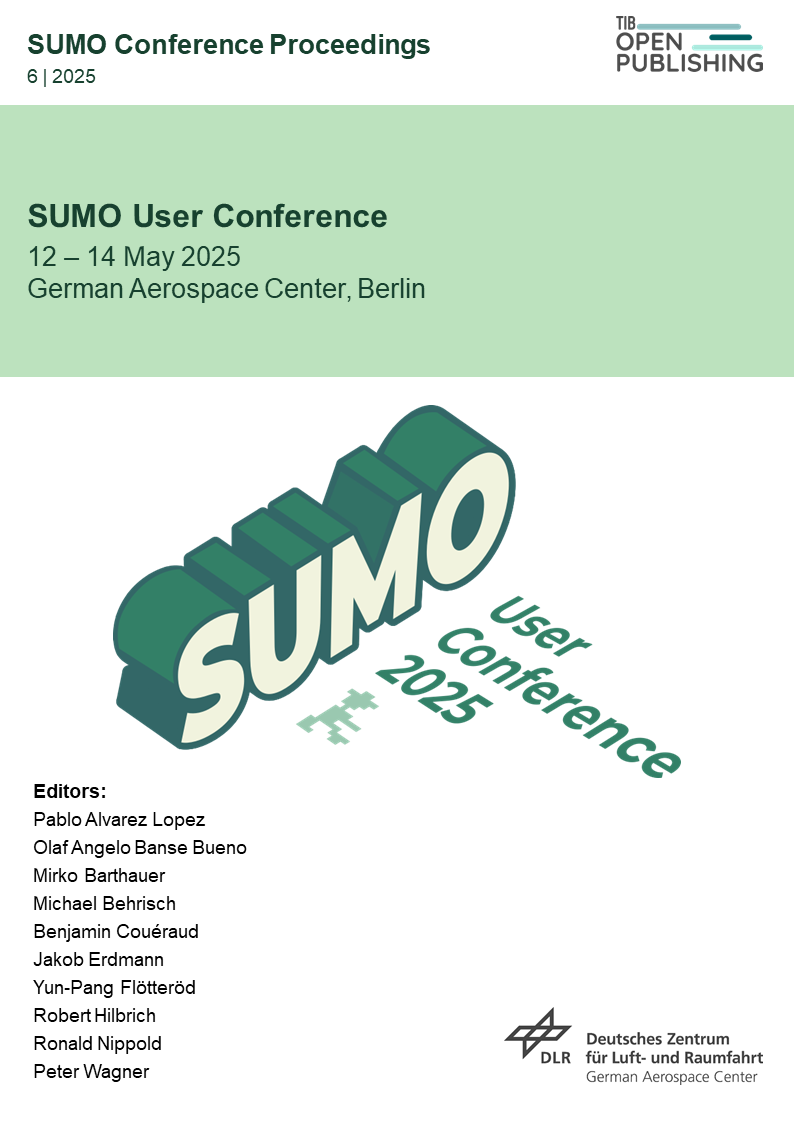Modeling Passenger Boarding Times Using Sumonity’s Sub-Microscopic Pedestrian Simulation
DOI:
https://doi.org/10.52825/scp.v6i.2618Keywords:
Sub-Microscopic Traffic Simulation, Pedestrian Modelling, Dwell Time, Microscopic Traffic SimulationAbstract
Short dwell times at bus stops are crucial for efficient public transport operations, yet existing traffic simulation tools commonly simplify passenger boarding. In this paper, we extend the SUMO-based co-simulation framework, Sumonity, to incorporate a sub-microscopic pedestrian model for city bus boarding. Our approach simulates real-time passenger flow, pathfinding, and door congestion in a Unity-based environment. We conduct a full-factorial simulation experiment with four bus door configurations, ranging from fully open double doors to partially closed options. We also consider different passenger loads between 1 and 50, yielding 200 unique scenarios. Detailed spatiotemporal data on passenger movements and boarding times are generated for each scenario. Analysis of crowding behaviors and door usage reveals significant sensitivity of boarding times to both passenger volume and door availability. These findings demonstrate the importance of accurately modeling pedestrian interactions for reliable dwell-time forecasts and underscore the potential of sub-microscopic pedestrian simulations.
Downloads
References
J. Lindner, M. Margreiter, and K. Bogenberger, "Public Transport goes Autonomous: Defining Functional Requirements for Automated Bus Transit Systems Based on Human Driver Tasks", 2024. DOI: 10.13140/RG.2.2.19339.91687.
M. Pechinger, and J. Lindner, "Sumonity: Bridging SUMO and Unity for Enhanced Traffic Simulation Experiences", in SUMO Conference Proceedings, vol. 5, 2024, pp. 163–177.
Transportation Research Board, Highway capacity manual, Transportation Research Board, National Research Council, 2000.
J. D. Fricker, "Bus dwell time analysis using on-board video", Transportation Research Board 90th Annual Meeting, Washington DC, United States, 2011. [Online]. Available: https://engineering.purdue.edu/~ce560/HW/Bus_Dwell_Time_jdf.pdf.
M. N. Milkovits, "Modeling the Factors Affecting Bus Stop Dwell Time: Use of Automatic Passenger Counting, Automatic Fare Counting, and Automatic Vehicle Location Data", Transportation Research Record: Journal of the Transportation Research Board, vol. 2072, no. 1, pp. 125–130, 2008. DOI: 10.3141/2072-13.
R. Rajbhandari, S. I. Chien, and J. R. Daniel, "Estimation of Bus Dwell Times with Automatic Passenger Counter Information", Transportation Research Record: Journal of the Transportation Research Board, vol. 1841, no. 1, pp. 120–127, 2003. DOI: 10.3141/1841-13.
G. Chen, L. Huang, H. Liu, and X. Yang, "Effects of bunching at stops on bus dwell time", in 16th International IEEE Conference on Intelligent Transportation Systems (ITSC), 2013, pp. 1499–1502. DOI: 10.1109/ITSC.2013.6728442.
R. Fernández, P. Zegers, G. Weber, and N. Tyler, "Influence of Platform Height, Door Width, and Fare Collection on Bus Dwell Time: Laboratory Evidence for Santiago de Chile", Transportation Research Record: Journal of the Transportation Research Board, vol. 2143, no. 1, pp. 59–66, 2010. DOI: 10.3141/2143-08.
K. J. Dueker, T. J. Kimpel, J. G. Strathman, and S. Callas, "Determinants of Bus Dwell Time", Journal of Public Transportation, vol. 7, no. 1, pp. 21–40, 2004. DOI: 10.5038/2375-0901.7.1.2.
L. P. Kostyniuk, and C. R. D’Souza, "Effect of passenger encumbrance and mobility aid use on dwell time variability in low-floor transit vehicles", Transportation Research Part A: Policy and Practice, vol. 132, pp. 872–881, 2020. DOI: 10.1016/j.tra.2020.01.002.
A. Tirachini, "Bus dwell time: The effect of different fare collection systems, bus floor level and age of passengers", Transportmetrica A: Transport Science, vol. 9, no. 1, pp. 28–49, 2013. DOI: 10.1080/18128602.2010.520277.
V. R. Vuchic, Urban Transit: Operations, Planning, and Economics, John Wiley & Sons, Inc., 2005.
E. I. Diab, and A. M. El-Geneidy, "The Farside Story: Measuring the Benefits of Bus Stop Location on Transit Performance", Transportation Research Record: Journal of the Transportation Research Board, vol. 2538, no. 1, pp. 1–10, 2015. DOI: 10.3141/2538-01.
H. L. Khoo, "Statistical Modeling of Bus Dwell Time at Stops", Journal of the Eastern Asia Society for Transportation Studies, vol. 10, pp. 1489–1500, 2013. DOI: 10.11175/easts.10.1489.
L. Sun, A. Tirachini, K. W. Axhausen, A. Erath, and D. Lee, "Models of bus boarding and alighting dynamics", Transportation Research Part A: Policy and Practice, vol. 69, pp. 447–460, 2014. DOI: 10.1016/j.tra.2014.09.007.
A. El-Geneidy, and N. Vijayakumar, "The Effects of Articulated Buses on Dwell and Running Times", Journal of Public Transportation, vol. 14, no. 3, pp. 63–86, 2011. DOI: 10.5038/2375-0901.14.3.4.
J. L. Machado-Le'on, D. MacKenzie, and A. Goodchild, "An empirical analysis of passenger vehicle dwell time and curb management strategies for ride-hailing pick-up/drop-off operations", Transportation, 2023. DOI: 10.1007/s11116-023-10380-6.
J. Xin, and S. Chen, "Bus Dwell Time Prediction Based on KNN", Procedia Engineering, vol. 137, pp. 283–288, 2016. DOI: 10.1016/j.proeng.2016.01.260.
S. Rashidi, S. Ataeian, and P. Ranjitkar, "Estimating bus dwell time: A review of the literature", Transport Reviews, vol. 43, no. 1, pp. 32–61, 2023. DOI: 10.1080/01441647.2021.2023692.
C. Iclodean, N. Cordos, and B. O. Varga, "Autonomous Shuttle Bus for Public Transportation: A Review", Energies, vol. 13, no. 11, p. 2917, 2020. DOI: 10.3390/en13112917.
M. Liu, T. Chen, C. Matunaga, Y. Oeda, and T. Sumi, "Simulation of dispersion effects by considering interactions of pedestrians and bicyclists using an agent space model", Computers, Environment and Urban Systems, vol. 91, p. 101725, Jan. 2022. ISSN: 0198-9715. DOI: 10.1016/j.compenvurbsys.2021.101725.
Weidmann, Ulrich, "Transporttechnik der Fussgänger: Transporttechnische Eigenschaften des Fussgängerverkehrs, Literaturauswertung", Tech. Rep., 1992. DOI: 10.3929/ETHZ-A-000687810.
Handbuch für die Bemessung von Straßenverkehrsanlagen, ser. FGSV W1 - Wissensdokumente, Ausg. 2015, Stand: 18.9.2015 ed., vol. Teil B, FGSV-Verl., Köln, 2015. ISBN: 9783864461033.
M. Campanella, S. Hoogendoorn, and W. Daamen, "Improving the Nomad microscopic walker model", IFAC Proceedings Volumes, vol. 42, no. 15, pp. 12–18, 2009. ISSN: 1474-6670. DOI: 10.3182/20090902-3-us-2007.0076.
Downloads
Published
How to Cite
Conference Proceedings Volume
Section
License
Copyright (c) 2025 Johannes Lindner, Mathias Pechinger, Klaus Bogenberger
https://creativecommons.org/licenses/by/3.0/de/deed.enAccepted 2025-04-25
Published 2025-07-15
Funding data
-
Bundesministerium für Wirtschaft und Energie
Grant numbers FKZ 19A22006T
